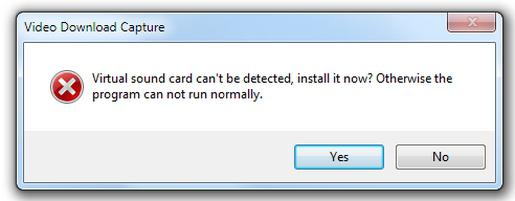Which is devoid of multimedia merits, will turn out to be an almost impossible test of imagination. Because the first thing that comes to mind is the pointlessness of using such a technique. At the same time, many of the owners of a modern computing device do not notice how enormous and unimaginably rich the creative potential inherent in this machine is. However, the often occurring problem “sound devices are not installed” still makes the user think that without audio support, a PC is a very boring device.
Let’s not remain silent about the problem: for novice users, an unexpected “boycott” of the system often becomes a kind of test, from which not every newbie manages to emerge victorious. But you, dear reader, are in luck! In just a few minutes you will be able to correct the situation. Simple but effective methods for restoring sound on a computer will help you detect and neutralize the unfavorable cause of electronic “silence” that has appeared out of nowhere. With your permission, let's move on to studying the material.
Audio controller - the device in which sound is generated
As you understand from all of the above, the article is dedicated specifically to those users who do not know where exactly to start when the system ambiguously reports that sound devices are not installed. Therefore, let's study the subject of our discussion in more detail.
Depending on the modification of the computer, the audio subsystem implemented in it can be of a discrete or integrated type. The most common is the latter type of device in question, the functionality of which is ensured through the coordinated operation of two basic elements: the controller host, which is part of the southbridge chipset, and A small chip located separately on the motherboard known as an audio codec.
However, in both cases, the process of troubleshooting the “sound devices not installed” type is almost identical, except for some nuances, which you will also become aware of from the material in this article.
Why the computer is silent: the main reasons and methods for detecting them
As practice shows, in most cases, problems with sound occur through the fault of the user himself. The main factor is the same inattention, as well as the reluctance inherent in many people to familiarize themselves with technical documentation PC. Often the user forgets to turn on the speakers or uses the audio jacks incorrectly. It's hard not to notice the crossed out speaker icon in the system tray, yet many people bother to ignore it. The possibility of mechanical damage to one of the connecting cords is often also discounted when troubleshooting audio problems. As a result of such banal omissions and an incorrectly assessed situation, the user begins to reinstall audio drivers, edit the registry, and, in general, experiment. As a rule, such rash actions lead to the previously mentioned problem. Therefore, to resolve the question: “Why are they not installed?” - you need to approach, so to speak, comprehensively and systematically, so as not to waste precious time and energy fighting “windmills.” However, let's move on.
What to do if we navigate the system on a computer
There are two types of malfunction: hardware and software. However, most often the “culprit” of silence is the second one. Therefore, to ensure otherwise, the first thing you need to do is check the system settings of your audio device:
- Click the Start button and go to the Control Panel menu.
- Next, go to the “Device Manager” section.
- Pay attention to the item “Sound, video and...”. If you see any “attention attributes” in it, then most likely the problems are caused by a malfunction of the installed driver.
- When the user does not observe any deviations in the mentioned section, it is likely that the “silent error” is hidden in one of the system settings items.
Forced retreat
Of course, the service message: “Sound devices are not installed” requires direct user intervention. Basically, the absence or inoperability of a critical driver is resolved by installing current version corresponding software. However, we will not remain silent about the fact that when following the mentioned instructions, some complications may arise that will become a kind of obstacle to achieving the expected result. A little later we will definitely consider such a multifaceted issue regarding the correct operation of the involved audio driver. Let's return to the previous discussion.
Checking the enabled parameters of the Windows Audio service
As a result of use third party software, and also in the case when the OS is “infected” with malicious machine code, system audio settings can be changed. As a result, it is unlikely that you will be able to successfully install a sound device: Windows 7 will still be “mute” (however, like any other version of the Microsoft system) if the operating parameters of the OS multimedia service are deactivated.
- Use the hotkey combination Win+R.
- In the Run box, enter the services.msc command.
- After the “Services” panel opens, from the presented list you need to select “Building Tools” endpoints Audio".
- After you double click mouse you will get to the service window of the service, pay attention to the “Startup type” checkbox: the value “Automatic” should be displayed there.
- After changes made activate the “Run” button.
If the above steps do not give a positive result, then proceed to the following instructions.
BIOS solution
Sometimes, in order to install an audio device on a computer, you need to use some parameters in the basic input/output system. Depending on the manufacturer, as well as the version of the BIOS firmware, the sections in which the audio component is configured may vary (both in name and location in the BSVV environment). Therefore, it is necessary to study the computer’s operational passport in more detail. However, you can always focus on the generally applicable words Audio, Sound or Controller. However, only if you are absolutely sure that you are in a specific section, specify the Enabled or Auto parameter.
How to install a sound device
Windows 7 or the subsequent eighth version of the OS, when installing any driver, checks whether the current user has administrator rights. As you understand, the subsequent process of driver implementation is only possible if you follow the above instructions. Let's move on to the practical part of our material.
- First of all, the old, broken audio driver needs to be removed. Moreover, with the subsequent use of a special utility (for example, CCleaner), the functionality of which has the ability to correct registry errors and uninstall residual entries in the Windows system log.
- Only after a reboot will you be able to correctly install the audio device on your computer using a stable version of the multimedia driver.

Learn more about the virus threat and an effective method for restoring the registry
As is known, harmful software can completely disable the operating system. In our case, it may well happen that a virus left unattended can damage some system files, which, one way or another, will affect the full performance of the OS.
- Scan your computer for malicious code. It is worth noting that sometimes traditional antivirus program powerless in such situations. Therefore after standard process scan, resort to third-party “disinfecting” utilities, such as Malwarebytes Anti-Malware.
Attention: quite often a common problem for many, when the computer writes: “Sound devices are not installed,” is the destructive result of malicious code embedded in the OS. Subsequent user actions aimed at reinstalling damaged software are blocked by the virus program. Therefore, the above recommendation should not be neglected. 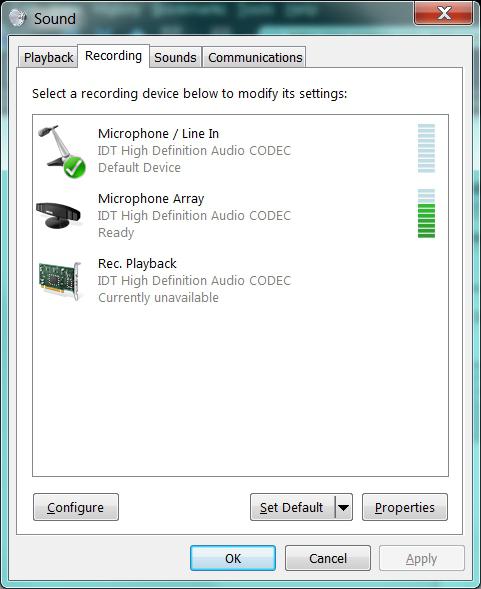
If software inconsistencies are detected, you must restart the PC. If the utility was unable to fix some problem areas of the OS, then you should resort to the process of restoring them. Select the previously created checkpoint and activate a system emergency rollback.
Other audio troubles, or What else prevents the user from installing an audio device
Working on a laptop is not only comfortable. Often a portable device is used as a multimedia center, especially when the laptop owner considers himself an incorrigible music lover. At the same time, intensive use in a mode when the speakers are operating at full power will sooner or later lead to the natural inevitability - “they have served their purpose.” Therefore, sometimes the problem of lost sound is resolved purely technically - by replacing the stereo pair. This, in general, is an expensive pleasure. Seeing a certain generality in portable configurations, it is worth noting that most modern laptops (including desktop modifications) are equipped with an Audio HD-standard sound circuit, which implies the use of a special audio controller.
Why can't I record?
"Sound devices are not installed" on in this case is not a problem. The solution lies in the correct connection of the recording device and in the system settings! 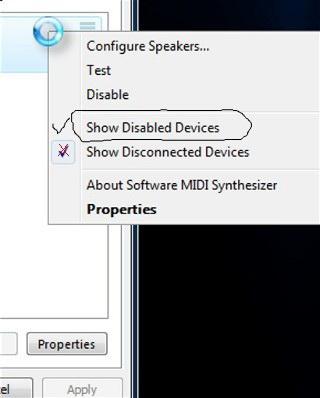
- Check that the microphone is inserted into the correct jack.
- Open the Start menu.
- Go to "Control Panel".
- Enter the "Sound" section.
- Now click on the “Record” tab.
- If on the list active devices There is a microphone, pay attention to the nearby indicator. When playing sounds, you should visually observe how the graphic equalizer comes to life.
- Otherwise, you need to make sure that the device is technically sound.
- If there is no microphone in the above list, then click right click mouse once in the work area of the service window. From the context list, select "Show unconnected...".
- Then click the manipulator key on the found element and activate the “Use as default” item.
Summing up
Of course, much did not fit into the scope of this article, but you, dear reader, still managed to get acquainted with the main reasons for often occurring situations when sound devices are not installed and the microphone does not work. Nevertheless, let's hope that the above recommendations will help you overcome the “sound” difficulty as a winner. Remember: when none of software methods restoring audio performance does not help, this is a hardware malfunction. Therefore, be prudent and seek help from specialists. Congratulations to you and quality recordings!
The motherboard may burn out or sound card, but often sound problems do not arise due to computer malfunctions. The point is in programs that turn out to be incompatible with each other or with Windows, and there are many important points is to work different types this family operating system.
Last time a large number of failures of sound devices or programs occur due to the “updating” of Windows XP to 7, or the transition from “seven” to Windows 8. A couple of years ago this was possible - reinstalling version 7 instead of XP, but now this cannot be done, because the models PCs have changed dramatically and are “hardwired” only for a specific Windows.
Even when installing more new version XP on old computer there may be a problem with sound, not to mention modern types Windows. New programs for which there are no drivers on the systems turn out to be incompatible.
You may have noticed that when you uninstall a program, you receive a warning that other applications may not function properly. This notice is especially important to consider when installing or uninstalling computer audio players, programs for formatting audio files, etc.
Solutions
Don't be alarmed by computer alerts that the system has not found any sound devices. Indeed, a last resort may be complete reinstallation operating system, but first you need to try some options.
Experienced users use Everest to learn more about their computer's sound card and find the appropriate driver for it. You can use the equally popular DriverPack program Solution, but it's better to try to find a solution yourself.
First you need to find out what modifications of devices are used on the computer. To do this, right-click on “My Computer” and in the context menu you will find the “Device Manager” tab. By clicking on it, you will see a list of computer devices.
Select "Other devices" or "Sound, video and gaming devices." If the driver is not listed, it means it doesn’t exist and you need to select it either on the computer manufacturer’s website, or simply search on the Internet.
In the 7th Windows manager devices can be found after clicking “Properties” in the “Computer” tab.
If you install the same operating system on different computers, do not be surprised to see a message about no sound - all computers have built-in different devices, requiring appropriate drivers.
It happens that when updating software, functions, in particular, of the sound card, are lost. For example, the default should be automatic switching on sound, but after a failure the card requires manual activation.
To check this, open Control Panel. By the way, the Panel view in XP can be either categorized or classic. You will see the proposed scheme in its classic form.
After Control Panel, open: “Administrative Tools”, “Services”, “ Windows Audio", "Properties", "Startup type". Select “Auto”, after which you will see system messages about the operating status of the device and the address of the executable Windows file. If none of the above helps, there is only one thing left to do - find a driver.
After reinstalling the operating system, problems with sound reproduction often occur. Sometimes this happens even when the sound drivers, as the user thinks, are in place. How to fix the situation? What to do if the sound does not work on Windows.
Reasons for the sound not working after re Windows installations maybe several
Why doesn't sound work on Windows 7 and other versions of the system?
The root of this problem is sound. Inappropriate devices may be installed by mistake.
Reference. A driver is a utility program that is responsible for the interaction of a PC with various devices and third party equipment. If your operating system is missing a specific driver, visit the center web page Windows compatibility. Here you will find information about hundreds of devices and links to download programs. Drivers can also be found on the disc included with your device.
Sometimes the solution to a problem is much simpler than we might imagine. If sound does not work on Windows 10, do not ignore these simple steps.
- Check that your speakers or headphones are connected correctly. Perhaps the cause of the sound problems lies in the cat’s self-will. It is worth making sure that the speakers are in good working order. To do this, connect them as headphones to your mobile phone.
- See if everything is ok with the playback devices. This can be done by opening the section of the same name, which is located in the control panel. To get into it, click on the volume icon. Then carefully study the properties of the speakers.
- If the computer is equipped special program, which services the sound card, open it and check if the sound is disabled. Obstacles to normal sound reproduction can be created by the optical output, while your speakers may be working.
- By pressing Win+R, enter devmgmt.msc into the line that appears. Then go to the "Sound, Game and Video Devices" section. After clicking on the name of the sound card, open “Properties”. Here you need to look at the information about the “Device Status”.
Disabling sound in BIOS
In some cases, audio can be disabled in the BIOS. Therefore, take the time to check the settings of this set of firmware. To enter it, after turning on the PC, press “Del”, “F2” or “Esc”. Then the message “Press Del (?) to enter Setup” should appear. Instead of “Del” the required key will be indicated.
Next, in the menu that appears, select the “Devices Configuration” paragraph. There should be a " High Definition Audio". If everything is fine, the value will be “Enabled”. It is not always necessary to reinstall the sound driver on Windows 7.
What should I do if there is no sound after installing Windows 7?
The fight against the problem should start from the control panel, or rather from the device manager. So, you will see whether audio devices are missing or installed. Most often it turns out that the necessary driver for sound is missing or the sound device is not installed.
Before searching the Internet for drivers, arm yourself with knowledge. First, find out the manufacturer and model motherboard. A receipt indicating the purchase of the computer or the markings on the motherboard will help you determine the model. Information about this item may be displayed when you turn on your PC.
If you have the necessary information, then go to the manufacturer’s website. Such resources have a section designed for downloading drivers. At the same time, do not confuse the resource belonging to the manufacturer of the motherboard with the website of the sound chip (the famous Realtek). It’s even better if you still have installation disk with drivers.
Now let’s talk in more detail about how to install an audio driver on Windows 7. You will have to follow the following steps to go to the “Device Manager”.
- Right-click on the “My Computer” icon and go to “Properties”.
- Go to the “Hardware” section by selecting “Device Manager”.
- Select the line with , video and other devices (the audio driver will be the first).
- Using the context menu, click “Update driver”.
- Click on the option “Search for drivers on this computer.”
- Specify the location where the driver is located, after which the system will begin updating.
You can install a sound device on Windows XP in the same way. If not on the official website required driver, you will have to spend more time. Help will be provided by specialized forums where users share ways to solve emerging problems.
WATCH THE VIDEO
A quick way to restore sound on Windows
If the sound does not work on Windows XP and a number of later versions of this operating system, the driver pack from the drp.su web resource will fix the problem. Service Driver utility Pack Solution can automatically detect your sound card and then install the appropriate drivers. It is a set of various software devices with automatic system installations. With its help, you can install sound devices on Windows 8 in a matter of minutes.
Driver Pack Solution is an effective tool for solving various work problems desktop computer, which cannot be said about overcoming.
The described methods for controlling sound in Windows 7 cannot be called a panacea. The problem could be much more serious. In addition, the methods listed above involve reinstalling the operating system. Therefore, it would not be superfluous to conduct a superficial check of the serviceability of sound devices.
Sound does not work on Windows 10: video solution
WATCH THE VIDEO
Now you know what to do if the sound does not work on Windows. Ask questions to the experts.
Today we’ll figure out why the audio output device is not installed in Windows 10, although the drivers for sound card installed, and the speakers or audio system have not been turned off recently.
- Physical damage to the audio playback device.
- Often the error occurs due to the lack of software to control the operation of the sound card or the use of a fairly outdated one or one designed for previous ones. Windows editions driver version.
- Incorrect speaker configuration.
Let's look at what to do in each case to solve the problem and return the computer to its normal operating mode.
Checking the sound system
Let's start correcting the situation from the first cause of the error. All that needs to be done here is to check whether the speakers, headphones or acoustics are connected correctly and make sure that the audio playback device is working properly by connecting it to another PC or smartphone.
Installing drivers
1. Find the manufacturer of the sound card (in the Task Manager, if the driver only needs to be updated, or in the instruction manual for the PC or motherboard/sound card).

2. Go to the official device support resource.
You should only install the driver downloaded from the official website! Using the Update Center or driver packs in such situations is often the source of the problem.
3. Download the installer version from there sound driver, designed for Windows 10 of the appropriate bit level (can be found through the “System” item in the Win→X menu).
4. Launch the installer and install the driver.
5. After completing the operation, be sure to restart the computer.
If installing the updated software did not help, move on.
1. Open “Device Manager” using Win→X.

2. Find the sound device in sound, gaming and other devices.
3. Open its “Properties”.
4. Click “Roll back driver” and confirm the operation.
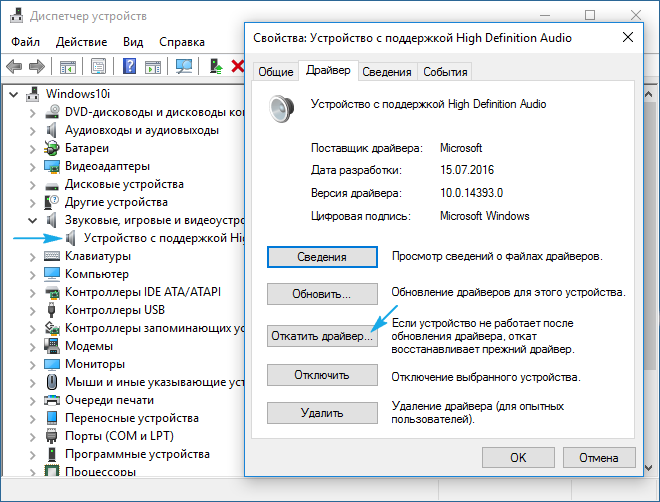
5. Upon completion, reboot.
We correctly indicate the device for playback
The last option to solve the problem is choice the necessary equipment to play sound. Perhaps the wrong stereo system is used by default in Windows 10 (this is important when several playback devices are connected or there are virtual sound devices).
1. Open context menu"Speakers" icons in the tray.
2. Click on the second item in the drop-down menu.

3. Select the current speakers.
4. Call up the context menu of their icons and click “Use as default” to make the speakers a device for playing sound.

You can also use the troubleshooting wizard (called through the speaker context menu).
![]()
Sometimes without visible reasons Sound devices on the computer stop working. The causes of the malfunction can be different: from complete shutdown, to hardware problems and sound failures of specific applications.
Hardware faults
If, when logging in, the message “No sound devices are installed” appears and a speaker icon with a cross appears on the taskbar, then there may be the following reasons:
- The drivers did not have time to load and in this case a simple reboot will help.
- The sound adapter is disabled in Windows Device Manager. This problem is also easily solved, just turn it on.
- The driver for the motherboard chipset is not installed. The solution is to put it in.
- Audio drivers do not work or are not installed. To fix it, you need to reinstall the drivers.
- The audio adapter or sound card is faulty.
If you are not a specialist, then it is better not to try to fix this problem yourself, but to contact a specialist.
After reinstalling the system
Sound functionality may stop working as a result of reinstalling the operating system. Windows systems. In general, everything necessary drivers can be found on the manufacturer's website. But, for example, if the hardware is old and its support has been discontinued, searching for drivers can take a huge amount of time.
To select the necessary software, go to Device Manager (Start-Control Panel-Devices and Printers) and look for the item “Sound, video and gaming devices”.
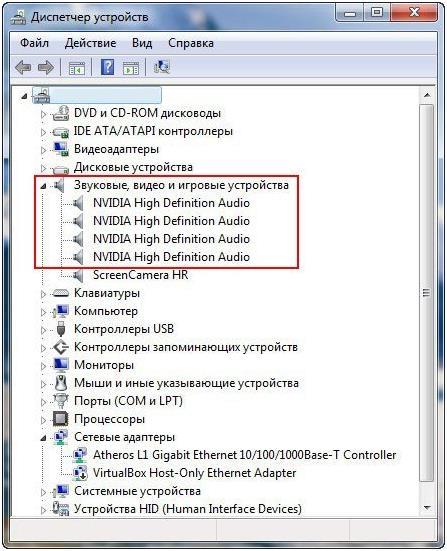 Although the device displays normally, no sound will appear unless the driver is installed. To find the right one, you need to find out which sound card is on your computer. To do this, you can use two ways: either look at search engine by ID, or use the AIDA program or its equivalent.
Although the device displays normally, no sound will appear unless the driver is installed. To find the right one, you need to find out which sound card is on your computer. To do this, you can use two ways: either look at search engine by ID, or use the AIDA program or its equivalent.
The most convenient way is to use the program. Download it, install and open it. Next in the window, select “Computer”, and then “Summary Information”. Everything that is installed on your computer will appear on the screen, including the connected sound adapter.
 Having found out the name and model, go to the official Realtek website and its top menu click Download. Among the presented drivers, select High Definition Audio Codecs (Software). This version is the most universal, supports all new audio formats and is suitable for everyone Windows versions. After downloading, run the file and follow the instructions and after installation, restart the computer, after which the sound will appear.
Having found out the name and model, go to the official Realtek website and its top menu click Download. Among the presented drivers, select High Definition Audio Codecs (Software). This version is the most universal, supports all new audio formats and is suitable for everyone Windows versions. After downloading, run the file and follow the instructions and after installation, restart the computer, after which the sound will appear.


